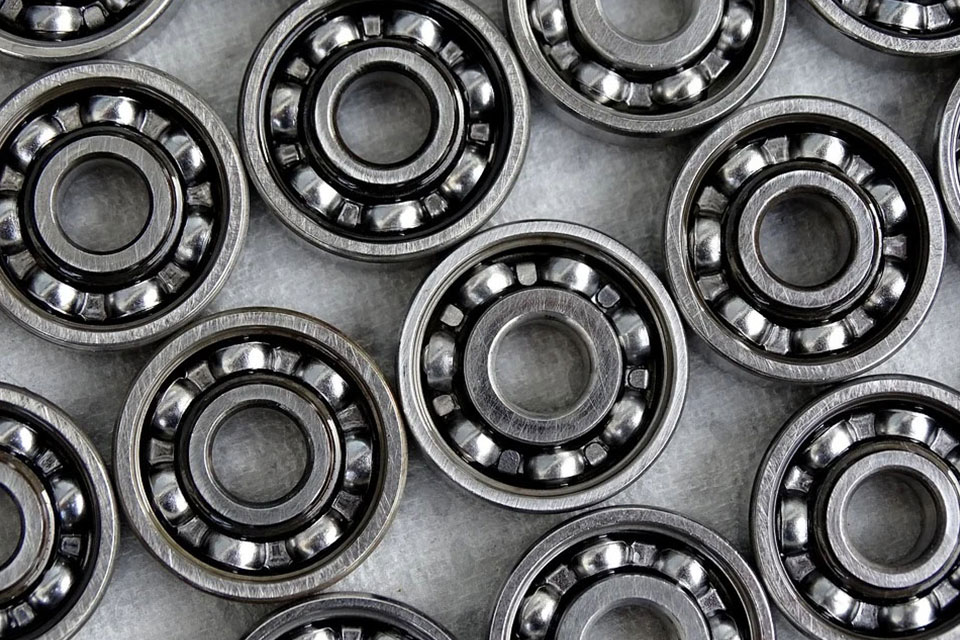You’ve probably used a ballpoint pen to write, a hard drive to store data, a skateboard to zoom around, and, of course, an electric motor to power a household machine or two. But do you wonder what makes them run so smoothly and quietly? Bearings make machines like these run. Without bearings, devices like these would wear out from the effects of friction, and would need to be replaced constantly.
Did you know that one of the advanced technologies used to help the San Francisco International Airport withstand earthquakes involves giant ball bearings? The 267 columns that support the weight of the airport each ride on a steel ball bearing five feet—that’s 1.5 meters—in diameter. The ball then rests in a concave base which is connected to the ground. In case of an earthquake, the ground can move 20 inches, or 51 centimeters, in any direction. The columns that rest on the balls will move less than this as they roll around in their bases which help isolate the building from the motion of the ground. Once the earthquake is over, gravity will pull the columns back to the center of their bases.
Now you know the important role bearings play in our modern life.
Bearings enable machinery to move at extremely high speeds and carry remarkable loads with ease and efficiency. Bearings handle two types of load: radial load and axial, or thrust, load. Depending on the location of the bearing, it can transmit all radial loading, all thrust loading, or a combination of both.
There are many types of bearings, each used for different purposes:
Ball Bearings
Ball bearings are probably the most common type of bearing. They are found in almost everything from skateboards to electric motors and even hard drives. Ball bearings are capable of handling both radial and thrust loads. Hence, these are used in applications where the load is relatively small. The load is transmitted from the outer race to the ball, and from the ball to the inner race. As the ball is a sphere, it only contacts the inner and outer race at a point, helping it spin very smoothly. If the bearing is overloaded, however, the balls can deform, ruining the bearing.
Roller Bearings
Roller bearings are mostly used in applications like conveyor belt rollers, where they hold heavy radial loads. The rolling element is a cylinder making contact between the inner and outer race in a line, rather than a single point. This helps to distribute load over a larger area, making these bearings capable of handling much greater loads as compared to a ball bearing. However, this type of bearing cannot handle much thrust loading.
Ball Thrust Bearing
Ball thrust bearings are usually used for low-speed applications, as they cannot handle much radial load. They support loads in one thrust direction only. Hence, these type of bearings can be found in furniture items such as bar stools and turntables.
Roller Thrust Bearing
Roller thrust bearings are often found in gear sets like those found in car transmissions, located between gears or between the housing and rotating shafts. These bearings can support large thrust loads. The helical gears used in most transmissions have angled teeth, causing a thrust load which must be supported by a bearing.
Needle Roller Bearing
Needle roller bearings are so named because they use elongated cylindrical rolling elements with small diameters. The diameter-to-length ratio for the needles varies between 1:2.5 and 1:10. They cannot be guided accurately, and generate high amounts of friction, so are used at low speeds in applications where radial space is limited.
Tapered Roller Bearings
These bearings are designed to withstand radial and thrust load. They are found in automobile wheel hubs due to the amount of bi-directional radial and thrust loads. The rings and rollers are both tapered in the shape of truncated cones to simultaneously support axial and radial loads. The ratio of the loads depends on the angle of the axes between the roller and bearing, meaning the greater the angle, the greater axial load that can be supported.
If you work with or study bearings, here’s everything you need to know.
